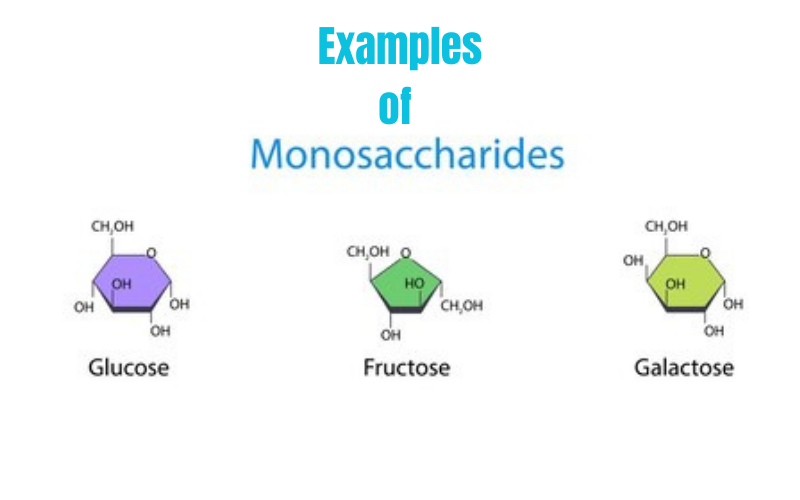Monosaccharides form the simplest type of carbohydrates. Examples of Monosaccharides comprise glucose, which serves as a major energy source for cells; fructose, a lovely sugar present in fruits and honey; galactose, which combines with glucose to produce lactose in milk; xylose, found in wood for use as a sweetener; and ribose, a component of RNA and ATP energy molecules.
Welcome to the sweet side of biochemistry! Today, we’re diving into the world of monosaccharides, those tiny but mighty sugars that make life a little bit sweeter. Get ready for a flavorful journey as we explore 15 examples of these single-unit sugars that play a crucial role in fueling our bodies and adding sweetness to the biological mix.
Examples of Monosaccharides
Here are 15 Examples of Monosaccharides:
1. Glucose: The Energy MVP
Let’s kick off our sugar expedition with the undeniable rockstar of monosaccharides – glucose. This sugar takes center stage as the energy powerhouse, fueling everything from intense workouts to those midday naps.
2. Fructose: The Fruit Whisperer
Meet fructose, the sugar that gives fruits their irresistible sweetness. It’s like nature’s way of saying, “Eat more fruit; it’s good for you!”
Also Read: Examples of Compounds
3. Galactose: The Dairy Dynamo
Got milk? You’ve got galactose too! This sugar teams up with glucose to create lactose, making your morning cereal a dairy delight.
4. Ribose: The RNA Romantic
Ribose is the poet of the monosaccharide crew, playing a key role in RNA – the romantic cousin of DNA. Think of it as the sugar that holds the love letters of life.
5. Deoxyribose: DNA’s Mysterious Sweetheart
Deoxyribose is the mysterious sugar that binds with DNA, making it the ultimate sweetheart in the genetic love story. It’s like the secret admirer of the biological world.
6. Mannose: The “Manly” Monosaccharide
Mannose might sound like a superhero’s sidekick, but it’s a sugar with its own strengths. It’s involved in cell communication and keeps things manly on a cellular level.
7. Xylose: The Eco-Friendly Sweetener
Xylose is the sugar that’s all about sustainability. Found in plants and wood, it’s the eco-friendly option for those who like their sweetness au naturel.
8. Arabinose: The “Ara-Ara” Sugar
Arabinose has a certain charm – it’s like the monosaccharide version of an “Ara-Ara” moment. It adds a subtle sweetness to the biological stage in some plants and bacteria.
9. Erythrose: The “Ethereal” Essence
Erythrose is the sugar that sounds like it belongs in a fantasy novel. A rare find in nature, it adds an ethereal touch to the sweetness spectrum.
10. Threose: The Tricky Teaser
Threose like to keep things interesting. A rare sugar that’s like a tricky teaser, showing up unexpectedly and leaving you wondering, “Where have you been all my life?”
11. Sorbose: The Sourpatch Kid
Sorbose is like the Sourpatch Kid of the sugar family. It’s not overwhelmingly sweet, but it adds a hint of sourness to the mix, keeping things balanced.
Also Read: Examples of Unsaturated Fats
12. Allose: The “Almost Glucose” Sibling
Allose is the sugar that’s almost like glucose but not quite. It’s like the sibling who looks similar but has its own unique personality. It keeps you guessing.
13. Altrose: The Alternative Sweetie
Altrose is the alternative sugar that’s not afraid to stand out. It’s not as common as its counterparts, but it brings its own sweetness to the table – a true sweetie in its own right.
14. Tagatose: The Tag-Team Champion
Tagatose is like the tag-team champion of sweetness. A low-calorie sugar that teams up with glucose to create a dynamic duo for those watching their sugar intake.
15. Psicose: The “Psychedelic” Sugar
Psicose is the sugar with a name that sounds a bit psychedelic. A low-calorie option with a sweet taste, making it the groovy choice for those looking to add a dash of sweetness to life.
So there you have it – a delightful journey through 15 examples of monosaccharides, each with its unique flavor and contribution to the sweet symphony of life. These sugars may be small, but their impact on our taste buds and biological processes is anything but tiny. Embrace the sweetness, enjoy the humor, and let the monosaccharide party continue!

